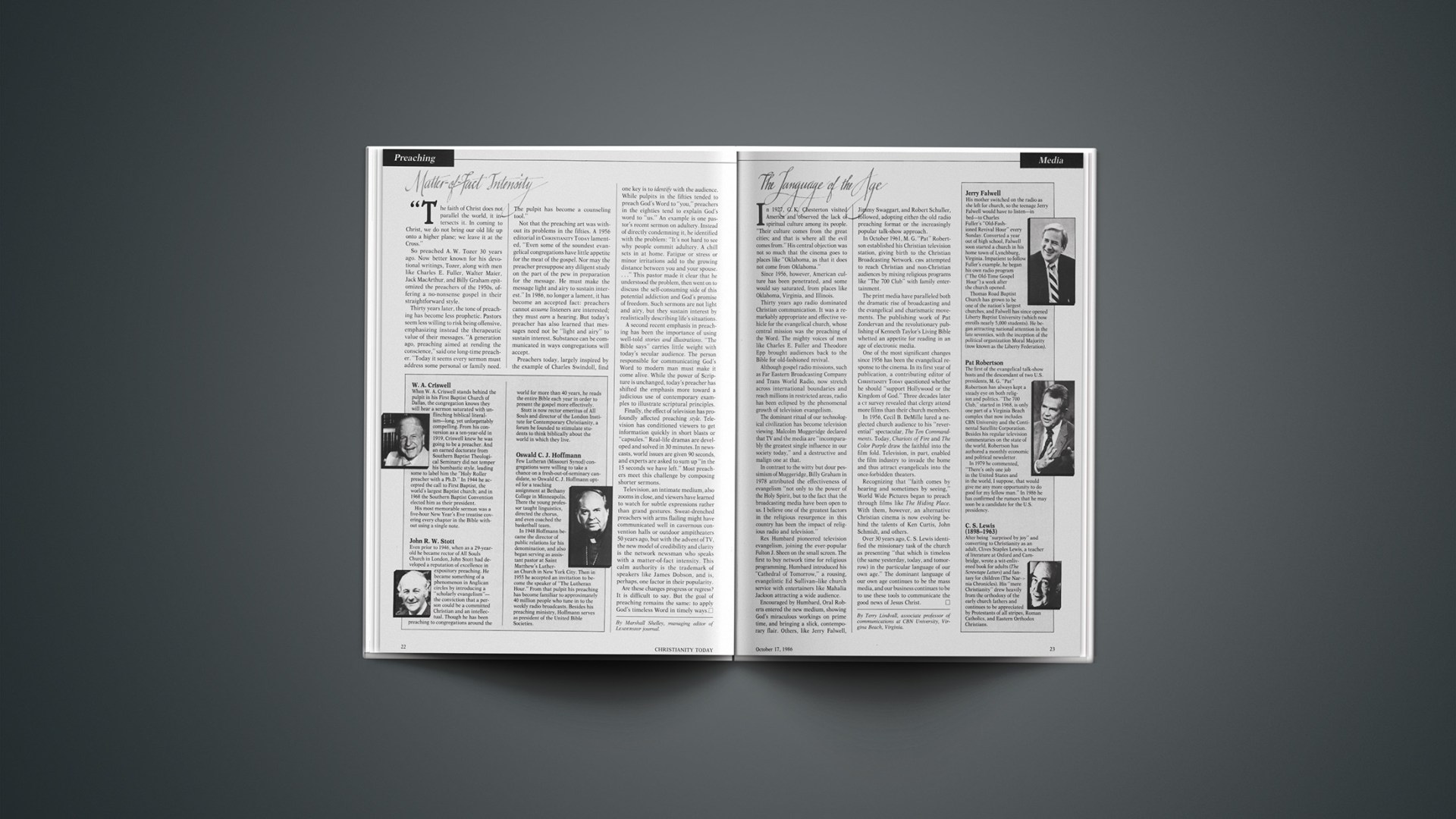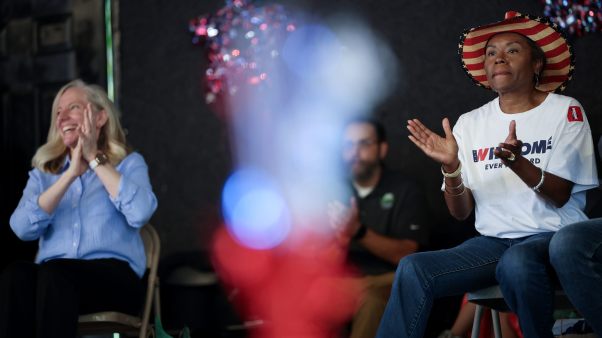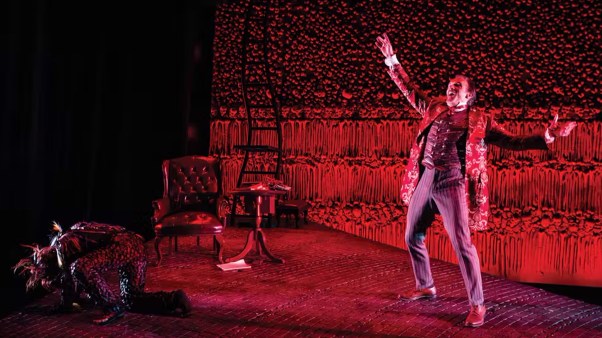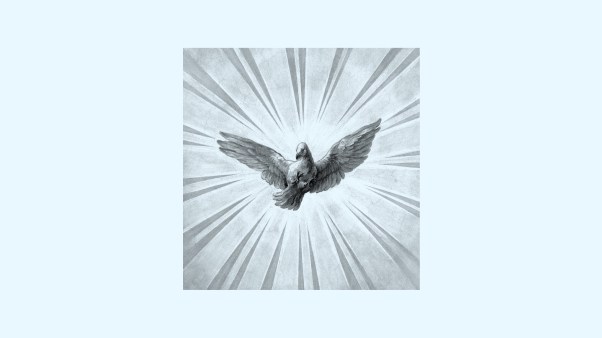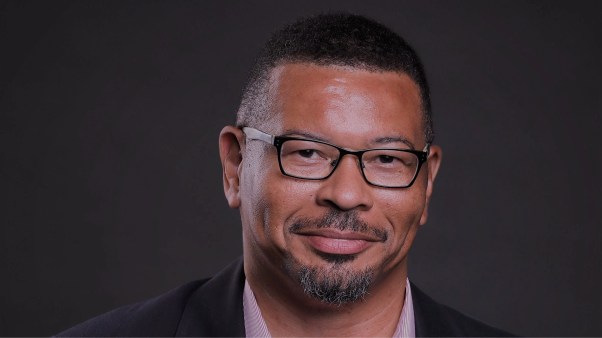In 1927, G. K. Chesterton visited America and observed the lack of spiritual culture among its people. “Their culture comes from the great cities; and that is where all the evil comes from.” His central objection was not so much that the cinema goes to places like “Oklahoma, as that it does not come from Oklahoma.”
Since 1956, however, American culture has been penetrated, and some would say saturated, from places like Oklahoma, Virginia, and Illinois.
Thirty years ago radio dominated Christian communication. It was a remarkably appropriate and effective vehicle for the evangelical church, whose central mission was the preaching of the Word. The mighty voices of men like Charles E. Fuller and Theodore Epp brought audiences back to the Bible for old-fashioned revival.
Although gospel radio missions, such as Far Eastern Broadcasting Company and Trans World Radio, now stretch across international boundaries and reach millions in restricted areas, radio has been eclipsed by the phenomenal growth of television evangelism.
The dominant ritual of our technological civilization has become television viewing. Malcolm Muggeridge declared that TV and the media are “incomparably the greatest single influence in our society today,” and a destructive and malign one at that.
In contrast to the witty but dour pessimism of Muggeridge, Billy Graham in 1978 attributed the effectiveness of evangelism “not only to the power of the Holy Spirit, but to the fact that the broadcasting media have been open to us. I believe one of the greatest factors in the religious resurgence in this country has been the impact of religious radio and television.”
Rex Humbard pioneered television evangelism, joining the ever-popular Fulton J. Sheen on the small screen. The first to buy network time for religious programming, Humbard introduced his “Cathedral of Tomorrow,” a rousing, evangelistic Ed Sullivan-like church service with entertainers like Mahalia Jackson attracting a wide audience.
Encouraged by Humbard, Oral Roberts entered the new medium, showing God’s miraculous workings on prime time, and bringing a slick, contemporary flair. Others, like Jerry Falwell, Jimmy Swaggart, and Robert Schuller, followed, adopting either the old radio preaching format or the increasingly popular talk-show approach.
In October 1961, M. G. “Pat” Robertson established his Christian television station, giving birth to the Christian Broadcasting Network, CBN attempted to reach Christian and non-Christian audiences by mixing religious programs like “The 700 Club” with family entertainment.
The print media have paralleled both the dramatic rise of broadcasting and the evangelical and charismatic movements. The publishing work of Pat Zondervan and the revolutionary publishing of Kenneth Taylor’s Living Bible whetted an appetite for reading in an age of electronic media.
One of the most significant changes since 1956 has been the evangelical response to the cinema. In its first year of publication, a contributing editor of CHRISTIANITY TODAY questioned whether he should “support Hollywood or the Kingdom of God.” Three decades later a CT survey revealed that clergy attend more films than their church members.
In 1956, Cecil B. DeMille lured a neglected church audience to his “reverential” spectacular, The Ten Commandments. Today, Chariots of Fire and The Color Purple draw the faithful into the film fold. Television, in part, enabled the film industry to invade the home and thus attract evangelicals into the once-forbidden theaters.
Recognizing that “faith comes by hearing and sometimes by seeing,” World Wide Pictures began to preach through films like The Hiding Place. With them, however, an alternative Christian cinema is now evolving behind the talents of Ken Curtis, John Schmidt, and others.
Over 30 years ago, C. S. Lewis identified the missionary task of the church as presenting “that which is timeless (the same yesterday, today, and tomorrow) in the particular language of our own age.” The dominant language of our own age continues to be the mass media, and our business continues to be to use these tools to communicate the good news of Jesus Christ.
By Terry Lindvall, associate professor of communications at CBN University, Virgina Beach, Virginia.
Jerry Falwell
His mother switched on the radio as she left for church, so the teenage Jerry Falwell would have to listen—in bed—to Charles Fuller’s “Old-Fashioned Revival Hour” every Sunday. Converted a year out of high school, Falwell soon started a church in his home town of Lynchburg, Virginia. Impatient to follow Fuller’s example, he began his own radio program (“The Old-Time Gospel Hour”) a week after the church opened.
Thomas Road Baptist Church has grown to be one of the nation’s largest churches, and Falwell has since opened Liberty Baptist University (which now enrolls nearly 5,000 students). He began attracting national attention in the late seventies, with the inception of the political organization Moral Majority (now known as the Liberty Federation).
Pat Robertson
The first of the evangelical talk-show hosts and the descendant of two U.S. presidents, M. G. “Pat” Robertson has always kept a steady eye on both religion and politics. “The 700 Club,” started in 1968, is only one part of a Virginia Beach complex that now includes CBN University and the Continental Satellite Corporation. Besides his regular television commentaries on the state of the world, Robertson has authored a monthly economic and political newsletter.
In 1979 he commented, “There’s only one job in the United States and in the world, I suppose, that would give me any more opportunity to do good for my fellow man.” In 1986 he has confirmed the rumors that he may soon be a candidate for the U.S. presidency.
C. S. Lewis (1898–1963)
After being “surprised by joy” and converting to Christianity as an adult, Clives Staples Lewis, a teacher of literature at Oxford and Cambridge, wrote a wit-enlivened book for adults (The Screwtape Letters) and fantasy for children (The Narnia Chronicles). His “mere Christianity” drew heavily from the orthodoxy of the early church fathers and continues to be appreciated by Protestants of all stripes, Roman Catholics, and Eastern Orthodox Christians.

